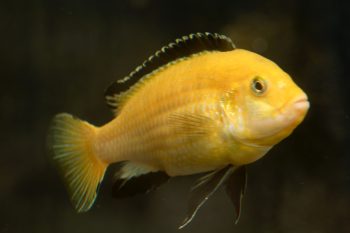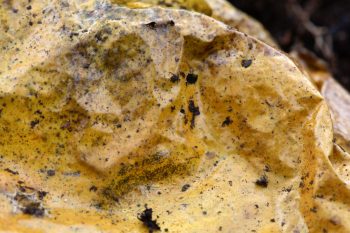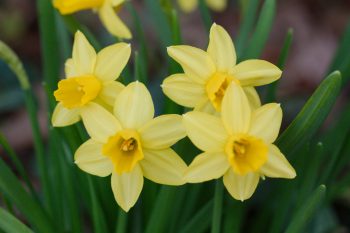I was trying to take pictures of my fish today. It’s harder than it sounds. First, you have to make sure the flash doesn’t reflect off the glass. Then, you have to avoid dirty areas on the glass. Also, they move about a bit and getting them in focus is hit or miss, even with auto focus. This is the best “whole fish” shot and even this isn’t as good as I’d like. The eye should be the point most in focus and it isn’t. Labidochromis caeruleus, by the way.
Tagged With: Yellow
Dried Tomato Skin
I was out cleaning out my vegetable garden today and found this old, dried out tomato skin, which I thought looked pretty cool, in an old, dried out sort of way. Some days I feel a little like this.
Forsythia
The forsythia in our back yard started blooming today. It’s a day or two behind the bushes in our neighbor’s yard because it’s not in as much sun, but it’s still nice and bright when in bloom.
Tree Flowers
These are the flowers on a small tree. Not sure what. Adds a nice touch of yellow to the otherwise mostly brown woods, though.
Yellow Jacket
I went out hoping to get a better butterfly picture today. I got a few but they aren’t enough better than yesterday’s picture to justify putting them here. So, here’s a picture of a yellow jacket on a garlic mustard flower.
Spiderwort
This is the first bloom on our Tradescantia (spiderwort) out front in the shade garden. This one is lighter purple than most but still quite pretty. I especially like the deep purple stamen hairs and the yellow anthers. Apparently, when the stamen hairs are exposed to ionizing radiation they turn pink. Looks like were safe, for now.
Bearded Iris
The irises are starting to bloom all over. This is a purple and yellow variety outside our dining room window. I think yellow and purple are a terrific color combination.
Black-eyed Susans
The black-eyed Susans are the predominant source of color (except for the color green, of course) in the garden right now. They are holding up their end marvelously, I might add.
Oh, and I passed the 20,000 mark on my camera today. This is photo number 20,004 (since Christmas).
Neighborhood Kids Go Bananas!
Yes, banana suits seem to be in this year. These four neighborhood kids are in my mother-in-law’s neighborhood, actually, not ours.
Coreopsis
This is a very nice Coreopsis (tickseed) growing in a container on our back patio. I like these larger-petaled Coreopsis flowers more than the fine-petaled varieties. I suppose they both have their uses but these are so much bolder and brighter. They certainly make a good show and outside the kitchen door is a nice place for a big splash of yellow. These are reliable blooms and come ahead of the sea of black-eyed Susans that fill our backyard later in the summer. For now, these are the sole source of this color in our garden (there are a few yellow irises but they are a much paler yellow).
Skipper on Coreopsis
I sat on the patio for a while this afternoon, just enjoying being in the sun. It was actually a little hot for my taste, but still nice for all of that. Also, the light is better for macro photography in the sun, when you want as much depth of field and as fast a shutter speed as possible. I was watching the insects around the potted flowers on the patio and got a few pictures of this skipper (family Hesperiidae) on a coreopsis (a.k.a. tickseed) flower. The insects aren’t around it the huge numbers we’ll have in a few weeks, particularly when the mountain mint (Pycnanthemum muticum) starts to bloom, but they are certainly here and I really enjoy them.
Lantana
Lantana is a genus of about 150 species. The mostly commonly grown species is Lantana camara, a tender, woody shrub native to tropical regions of Central and South America. It has become an invasive weed in many parts of the world but here, where winter temperatures are too cold for it, there’s no chance of any real problem and it is grown as an annual. It is toxic to livestock but it does not appear to be toxic to humans (although I don’t think I’ll be doing any experiments on that). The flowers are quite beautiful, changing colors as they progress from bud to open flower, leading to some wonderful color combinations. This one is sitting on our driveway and is quite happily brightening up the place with its yellow and pink blooms.
Skipper on Rudbekia
The skippers are a constant source of attraction pretty much all summer and into the fall in our yard. They may have their favorites but they are generally everywhere, from the black-eye Susans (Rudbekia) as seen here, to the Verbena bonariensis, the mountain mint (Pycnanthemum muticum), and the Buddleia. They are everywhere and it pretty huge numbers. If you walk along the edge of the black-eyed Susans, they fly off en masse and alight again, further along or behind you. It’s enjoyable just to watch them flitting about, sometimes two or even three on a flower, but not usually for long, as they are so often on the move.
Zinnia
When we moved into our house 11 years ago there was a large oak tree centered at the front of the property. It was not a healthy tree and was in the slow process of dying. Because it was actually in the road right-of-way, the county came (at our request) and took it down. Since then Cathy has planted mostly annuals every spring in the spot where it used to be. These are generally brightly colored zinnias and marigolds, although there are other plants as well as a few containers with even more variety. This is the flower from one of the zinnias.
Vespa crabro (European Hornet)
I went out back to see what I could find to photograph this evening. There was a painted lady (Vanessa cardui) butterfly on the Buddleia and I got some reasonable but not great pictures of that. Then I noticed this large, yellow and brown wasp on the steps. This is a large wasp, about 2cm in length. Not as big as the eastern cicada killer (Sphecius speciosus) but still a pretty good size. As the common name implies, these are native to Eurasia. They were introduced to eastern North America in the 1800s. They are one of the many wasps to build paper nests out of chewed wood pulp.
Lake Needwood Wood
I’m a fan of the woods. I love the colors, the sounds, and the smells. I won’t say there’s nothing I don’t like about woods but in general I’d say the things I like outweigh the things I don’t like. Of course, I’m happy that I live in a modern house with running water, central heating and air conditioning, a roof to keep off the rain, and electricity and gas to power all sorts of appliances. I do like a walk in the woods, though. In the autumn, with the colors in the trees, it is especially nice. A rainy day, practically any time of year but particularly in the spring when the leaves are various shades of green is also a wonderful time for a walk in the woods. But today was glorious and bright and cool.
Echeveria Flowers
It snowed lightly this morning but by the time we were home from church it had all turned to rain. It was a fairly heavy rain and a fairly gloomy, cool day. Cathy and I decided we’d like to see a little green so we went to Behnke in Beltsville to spend a little time in their greenhouse looking at house plants. There were a few things we were interested in but didn’t actually buy anything this time. These little yellow flowers are on what I think is an Echeveria, although I didn’t actually check and often they are labeled simply “succulent”. It was a nice outing and a nice way to spend a cold, rainy Sunday afternoon.
Eranthis hyemalis
As mentioned in yesterday’s post, the winter aconite (Eranthis hyemalis) is blooming here. I only have two small plants but the seem to be growing a small amount each year. Mom has a nice, dense patch of them near the foot of the driveway and I love seeing them at this time of the year. They are in the family Ranunculaceae (the buttercup family) and are very reliable, very long lived little plnts. They are, I’m afraid, fairly slow to get established and I haven’t had huge success with them. Still, thase that did make it are here for the long haul.
Daffodil ‘Tete-A-Tete’
Since last week’s snow, it’s been relatively balmy and spring-like. The daffodils were already coming up when the snow came, with a few already in bloom. Now, a little more than a week later, they are bursting into bloom all over. Shortly we’ll have great drifts of yellow where the highway department has planted them alongside roadways. Front yards will be sporting the beautiful yellow flowers, dancing in the breeze (a la William Wordsworth). This little one is the earliest in our yard, to be followed shortly by the much larger and dare I say quintessential ‘Marieke’, along our front walk.
Daffodil ‘Arkle’
This isn’t a great picture but I’m pretty pleased with these daffodils. It’s a variety called ‘Arkle’ and I planted them in the fall of 2014, making this their fourth spring in our yard. They are still just getting established, with two or occasionally three blooms per bulb in contrast to those that have been here for ten years or so, which have five of six per bulb. Nevertheless, these are lovely, huge, bright yellow flowers on tall, strong stems and I’m happy to have them. These were bought in 2014 in two orders totaling 535 bulbs, the last, large order I’ve made.




















